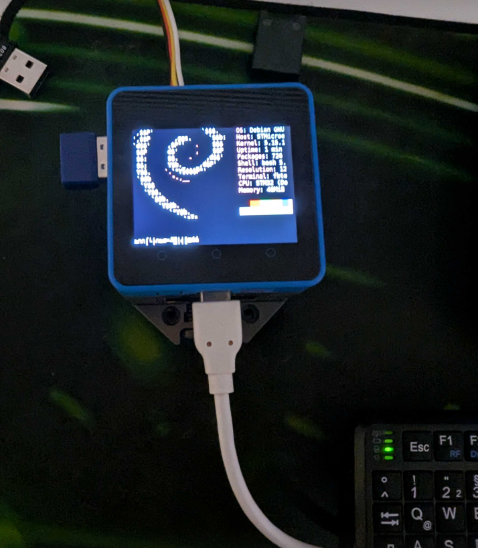Display terminal (tty) on CoreMP135 buildin display
-
Hi,
I am running a CoreMP135 with the M5 debian image (kernel 5.15). I am interacting with the device over USB-C / serial tty. How can I show the tty terminal on the buildin display? If connect an external monitor via hdmi it will directly show a tty terminal on the external monitor, can i get the same output on the ILI9342C LCD?
Thanks
-
@johan_s You will need to create a program that to capture the the terminal and display it.
-
Hi @ajb2k3 can you elaborate?
I think it should be possible to get a terminal on the LCD using the tools provided by the linux distribution. What i gathered from searching on google, is that
fbconcan be used to display terminals on framebuffers (such as the ILI9342C). Unfortunately,fbconis not included in the CoreMP135 Debian image. I am now playing around with the CoreMP135_buildroot repo to see if I can compile it there. I will keep digging. -
@johan_s unfortunately I only know the theory and haven’t had much time to work on documentation as having to move my hose and office around. I started looking into the firmware and I/o control just didn’t get very far. I need to dig through not the Devicetree and display code.
Have you tried installing FBCon yet?
-
Hi @ajb2k3 , ok that makes sense, no problem.
Yesterday, I tried a to use the
fbtermbecause it is included in the Debian repo (easy to install with apt), but I unfortutaly I could not get it work.I have been looking for
fbconin the buildroot configuration menu but I have not been able to find it so far. But I have noticed that buildroot underkernel extensionsinclude an optoin to compileFB TFT drivers. I will try and recompile with the FB TFT drivers tonight.I will post updates here.
The CoreMP135 is a cool little device, but it is not as easy to use as the other M5 controllers.
-
@ajb2k3 OK, I figured it out using FbTerm, see my notes below. Just a note to temper expectations: The device is not very powerful (surprise). In my case, I am running Debian, connected to two tty terminals (ttyGS0 over USB-C and tty1 being shown in display), connected over WiFi dongle, and added a BT dongle for keyboard/mouse, and as a result the CoreMP135 very easily becomes sluggish and quite warm.
Anyway, here are my notes
Showing a terminal on the LCD TFT display
Very briefly:
- The CoreMP135 contains a ILITEK ILI9342C LCD TFT display with touch
- The Debian OS recognizes as the display as a framebuffer and makes it accesible at
/dev/fb1 - Low level interaction directly with
fb1is below, see examples below. In all the included examples, I was signed in asrootvia the USB-C interface (ttyGS0)
# signed in as root cat /dev/zero > /dev/fb1 # clear display cat /dev/urandom > /dev/fb1 # show random 'static' on display echo "HELLO WORLD" > /dev/fb1 # will show some extremely small in the top left corner - not discernible- The M5Stack CoreMP135 Debian image includes
fbv- a program for rendering.jpgon the framebuffer (TFT LCD). Example:
# signed in as root . /usr/local/m5stack/bashrc # prepare environment for using fbv /usr/local/m5stack/bin/fbv /root/mycoolpic.jpg # display .jpg on framebuffer, might only show part depending on jpg resolution- It is also possible to show a (somewhat) fully functional terminal on the TFT LCD display using the
fbtermprogram:
# signed in as root apt install fbterm # install FbTerm export FRAMEBUFFER=/dev/fb1 # Tell FbTerm to use fb1 as framebuffer fbterm -s 12 < /dev/tty1 & # Tell fbterm to diplay tty1 terminal on fb1 with size 12.- Connect a BT keyboard or similar and enjoy a somewhat functional terminal
- One final note: I added
rootto thevideogroup, although this should not be required.

-
@johan_s I saw the export frame buffer on the CM4 stack but haven’t had time to look into it as moving around the house. Thanks for continuing the work in my steed
-
I haven't tested yet but on other devices I usually start programs from the serial console or SSH just by adding CLI arguments like this:
FRAMEBUFFER=/dev/fb1 <some command> -
@ajb2k3 no problem my friend
@prima I tried your suggestion but I can't really get it to work.
With the method I outlined the terminal works fine, but the keyboard input (USB keyboard) is not so reliable. It stop registering keystrokes after a short period. Not sure if the keyboard input get redirected to another terminal in the background or something.
-
@johan_s Hi John sorry for the long delay.
I had a chance to play with the frame buffer today after remembering this conversation.
I am finding the issue with the small text/garbidge written to the screen that you shared and looking into it.
Thanks for the point out.